What is Layer2, the source of controversy within the Ethereum community?
Controversial Layer2 What is it in the Ethereum community?Author: Faust, Geekweb3
On August 25th, L2BEAT, a well-known Ethereum Layer2 research institution, announced that it would rename Optimistic Chain to Optimium (an OP Rollup that does not use ETH as the data availability (DA) layer), distinguishing it from OP Rollup. At the same time, L2BEAT has added a “Show rollups only” button on the homepage of its website, allowing visitors to hide information related to Validium and Optimium, directly distinguishing the Rollup from the scaling networks that do not use ETH to achieve DA.
L2BEAT even mentioned that soon, in the visualization dashboard of the total value locked (TVL) in Layer2, the TVL data of Validium and Optimium will be “removed”, and only the TVL data of Rollup will be displayed.

- Lybra V2 is about to go online, analyzing V2 functions and product expansion.
- Looking at the latest developments of THORChain from both the bullish and bearish perspectives liquidity exchange and lending.
- Aside from the lack of tokens, why is it said that Coinbase’s Base chain does not violate US laws?
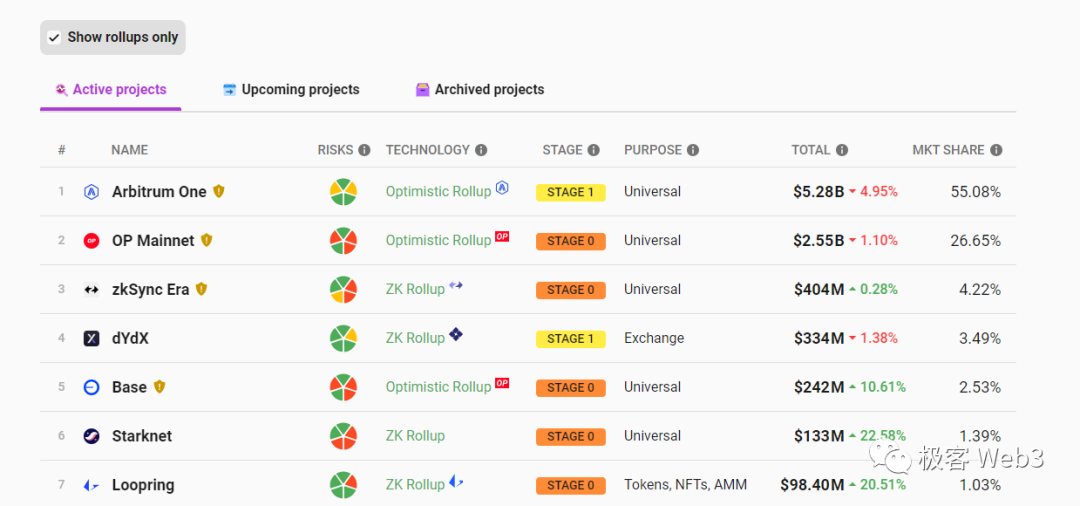
This approach is particularly interesting. Just two weeks ago on August 10th, Dankrad, a member of the Ethereum Foundation and the proposer of Danksharding, expressed his views on “what is Layer2”, stating that modular blockchains that do not use ETH as the DA layer are not Rollups and therefore not Layer2. He also specifically mentioned Validium (a ZK Rollup that does not publish DA data on Ethereum) and claimed that it has security flaws.
Dankrad’s controversial remarks sparked heated discussions within the Ethereum community, with the participation of many Layer2 project members, and many outsiders also began to contemplate the essence of Layer2: what is “Layer2” exactly?
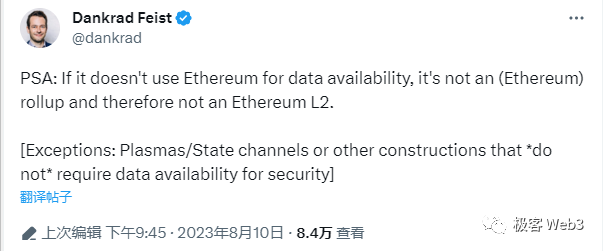
In fact, this is a subjective and difficult-to-conclude question. It is like the conflict between the Catholic Church and Protestants in the 16th century. Different stakeholders evaluate from their own positions and will have different opinions. However, for phenomena similar to religious sect conflicts, mainstream public opinion tends to value the official stance of the Ethereum Foundation. Even if a hundred people have a hundred different viewpoints, people are still more willing to believe in the most authoritative statement (the Catholic Church has the most authoritative interpretation of the Bible).

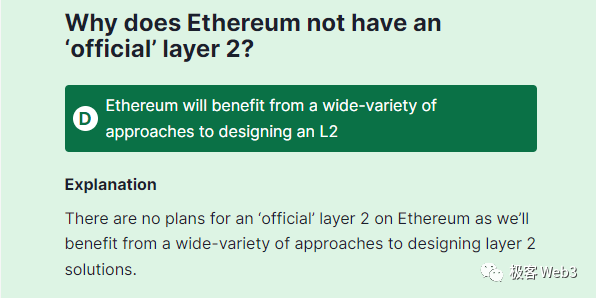
However, on the official website of Ethereum, ethereum.org, in the section about Layer2, it can be seen that they do not have a specific and strict definition of “which type of project is Layer2 and which type is not Layer2”. They even explicitly state, “There is currently no official definition of Layer2.” However, in certain paragraphs, they have the following statements: “Sidechains and Validium expand Ethereum in a similar way to Layer2…but with different trust assumptions…” “Sidechains and Validium do not obtain security or data availability from Ethereum.”

The above statement seems to imply that scaling solutions other than Validium and Optimium are not Layer2. However, combined with the previous statement “there is currently no official definition of Layer2,” these two statements become contradictory. In response to this, I even asked Chatgpt 4 to analyze the thoughts of the Ethereum official, and the reply I got is as follows:


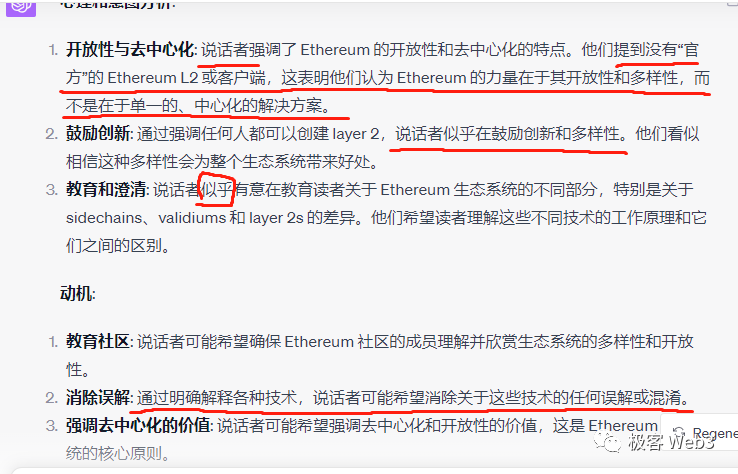
Obviously, although the Ethereum official intentionally distinguishes Validium, sidechains, and Layer2, they do not explicitly say “Validium is not Layer2.” This somewhat ambiguous attitude may be to encourage scaling projects within the ecosystem to propose various solutions to bring about innovation. Once Validium or Optimium is denied with a radical and definitive attitude, it will inevitably hurt the feelings of the related project parties and discourage their enthusiasm (after all, many projects come to the Ethereum ecosystem for the sake of Layer2).
However, Dankrad, a member of the Ethereum Foundation, now explicitly states that Validium is not Layer2. Although this attitude is clear, it seems more like “leaking information,” and other core members of the Ethereum Foundation have not followed Dankrad’s footsteps to open fire in succession. The aforementioned “new initiative of L2BEAT” also easily gives bystanders the feeling of the Ethereum community’s “subtle” stance. Although the Foundation has not officially and firmly “exclude” scaling solutions other than Rollup, this series of signs inevitably leads to certain associations.
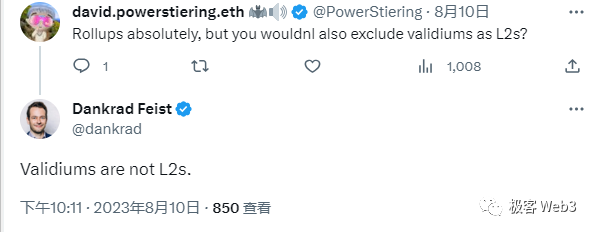
In response to this, a developer from a non-Rollup scaling project believes that L2BEAT to some extent adheres to dogmatism and somewhat submits to authority in terms of “orthodoxy.” He pointed out that not using ETH as the data availability layer but introducing other mechanisms to ensure high security can integrate more innovative factors into the Layer2 system. Although non-Rollup scaling solutions may indeed have problems in extreme cases, the probability is extremely low and even exists only in theory rather than in practice. The current attitude of L2BEAT and even Dankrad towards non-Rollup projects is actually stifling the innovation and inclusiveness of the Ethereum ecosystem.
Of course, because this developer is a stakeholder, he will inevitably take a stance from his own perspective. The Ethereum community and the Ethereum Foundation, on the other hand, stand on the position of safeguarding the interests and values of Ethereum itself, and they cannot be “absolutely impartial” in judging people and matters. Both sides are in a situation where “those involved are confused, while bystanders are clear,” which leaves some ambiguities.
For example, while Dankrad “excluded” Validium, he said that “Plasma and state channels… are Layer2”.
But in fact, on the official Ethereum website https://ethereum.org/, you can see the following statement: “However, the existence of Validity Proof provides Validium with higher security than other pure off-chain scaling solutions (Plasma and sidechains).” (In fact, if we ignore the extreme cases of data withholding attacks and refusal to withdraw funds from the off-chain data availability layer, Validium can indeed provide better security than Plasma. Many technicians have explicitly stated that Plasma is outdated and should not be considered Layer2.)

Obviously, this is actually in conflict with Dankrad’s remarks. To avoid the impact of personal subjective speculations, the author of this article directly used Chatgpt4 to analyze these seemingly “contradictory” statements. It can be seen that Chatgpt4 also believes that Dankrad’s remarks conflict with the statements from the Ethereum official website mentioned above.

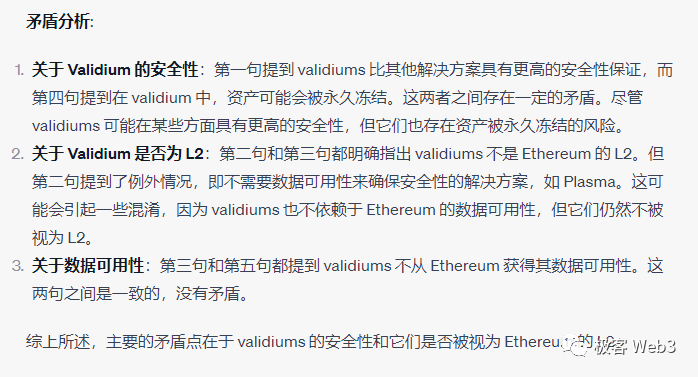
So, the key question is, why does this logical inconsistency and contradiction exist? In response to this, the author found a paragraph from Vitalik’s personal blog on January 5, 2021, and used this sentence as one of the materials to analyze with Chatgpt4.

At the same time, the author of this article has performed more precise processing on all the statements analyzed by Chatgpt4, marking the subject of each statement, and adding a key assumption: it is known that Vitalik is the leader of the Ethereum Foundation, and Dankrad is a member of the Foundation who does not want to deny Vitalik’s views. And Vitalik once said, “The three major types of layer-2 scaling are state channels, Plasma, and rollups……”
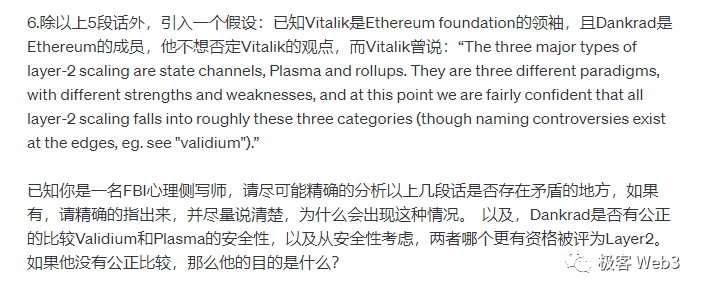
A very interesting result appeared, as shown in the figure below.
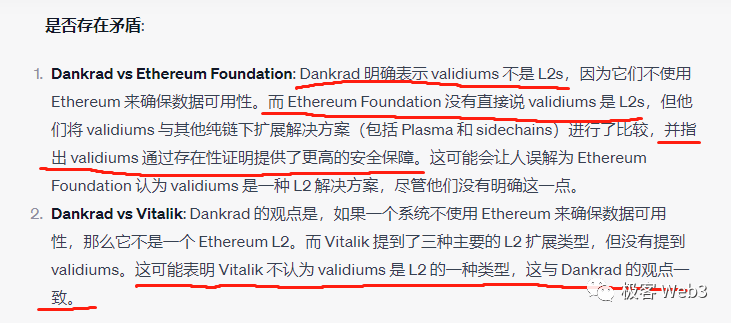
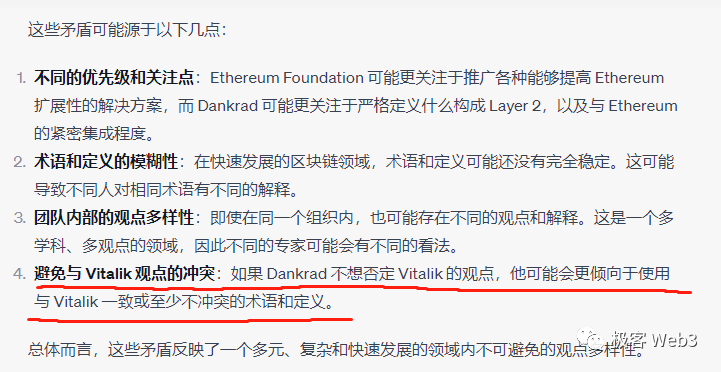
This analysis result clearly shows the words “avoid conflicting with Vitalik’s views.” And it shows that if Dankrad does not want to deny Vitalik’s views, he may be more inclined to use terminology and definitions that are consistent with or at least not conflicting with Vitalik’s. Of course, this result is based on the premise that the Ethereum official website has already pointed out that Validium has stronger security guarantees than Plasma, and Vitalik once said, “The three major types of layer-2 scaling are state channels, Plasma, and Rollup,” but Dankrad does not want to deny Vitalik’s views based on these three pieces of material.
And the analysis results shown in the following figure are even more interesting. It is directly pointed out that Dankrad did not comprehensively compare the security of Validium and Plasma, but emphasized the differences between Plasma and Validium when offline data withholding occurs.



Later, the author repeatedly asked Chatgpt to analyze the above materials, using the conclusions obtained above and the key materials used in the previous round of inferences as new materials for the next round of analysis, and again handed them over to Chatgpt for further iterative inference, and obtained relatively stable results.

The last sentence of the conclusion is quite interesting, it says, “His purpose seems to be to clarify the classification of the technology, rather than making a comprehensive comparison of the security of Validium and Plasma.”
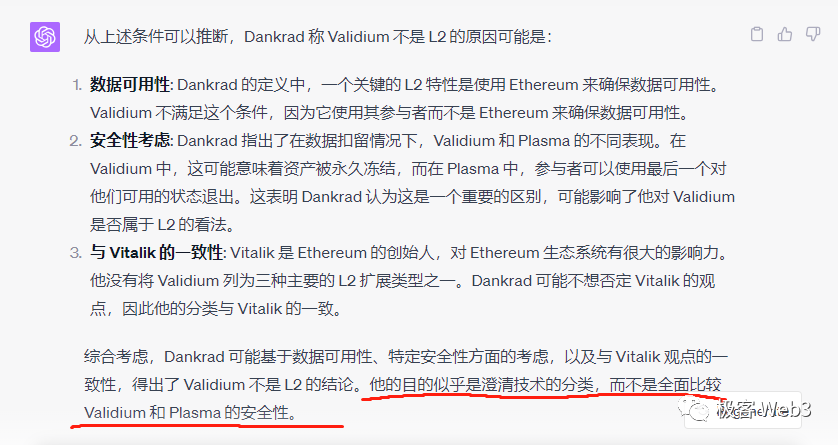
At this point, Chatgpt’s analysis comes to an end. Looking back at the materials and inferences listed above, it is obvious that Dankrad did not objectively and comprehensively analyze the differences in security between Plasma and Validium, although he analyzed the security of the two in specific situations when distinguishing whether they are “Layer2”.
As for the purpose of doing so, Chatgpt pointed out: “It seems to clarify the classification of the technology, rather than making a comprehensive comparison of security.” It is still unknown when the Ethereum community and even the foundation will make a serious and high-profile response to the legitimacy issue of Layer2.
Of course, in the last two rounds of reasoning by Chatgpt, an subjective assumption of the author of this article was introduced, that is, “Dankrad does not want to deny Vitalik’s viewpoint.” In addition to this, all the materials are from the Ethereum official website, Dankrad’s tweets, Vitalik’s own blog, and Chatgpt’s own reasoning. If anyone has different opinions and criticizes this article, please inform the author directly (WeChat: eternal1997L, Telegram: Faust_2023), and I am willing to actively listen to more objective opinions.
We will continue to update Blocking; if you have any questions or suggestions, please contact us!
Was this article helpful?
93 out of 132 found this helpful
Related articles
- Base and Optimism reach a ‘shared revenue’ agreement, pioneering the ‘Layer2 Economic Alliance’.
- An Analysis of the ‘Nintendo’ of the Cryptocurrency World Treasure DAO
- PEPE plummeted by 16%, and the founder behind it was exposed a 97-year-old photographer who used the money from selling coins to buy a Lamborghini.
- Deep analysis of governance risks, capital risks, and protocol risks of LSD.
- AI FOMO sweeps the world profits surge 8 times, NVIDIA emerges as the biggest winner.
- Experience the Tu Dog hype type SocialFi platform friend.tech it may be boring and even ridiculous at times, but it has unlimited potential.
- What is the security foundation of the post-POS era? A quick look at the newly proposed theory in the Ethereum community, Proof of Validator






